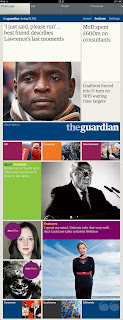IN THE SAME WAY as early automobiles looked like horse carriages, the pioneers among newspaper and magazine apps have born a striking resemblance to their origin: newspapers and magazines. For this as well as other reasons, sometimes it might have been a bit hard to see what important needs this new publishing format was actually meeting … if you count away that luxurious feeling of being able to read your Danish morning paper by an Italian swimming pool.
It has been claimed that the so-called tablet has the potential to change our reading habits – and now all of a sudden, this statement sounds more plausible. An important change appeared two months ago when the British newspaper The Guardian launched its long-awaited iPad app. Which looks nothing like a newspaper. It looks like a Mondrian painting. Or, even more perhaps, it looks like a Montana shelving system.
NAVIGATING IT will give you the same pleasant feeling as walking around inside a great piece of architecture or using a really well-designed tool. The surroundings are simple, beautiful, and functional, and using this application feels natural and intuitive from the very first visit.
The architecture is profoundly simple, based on a grid consisting of squares which can be combined to form rectangles of varying shapes and sizes. The typography has been completely adjusted to the grid and this contributes to the overall impression of quality.
Content-wise, the iPad version is based on the daily paper, and transformation into tablet format is done semi-automatically. A script analyzes the InDesign pages and reshapes the stories while preserving the editorial hierarchy. The publisher’s ambition is to give readers the same sense of overview as when browsing through a ”real” paper – in which headlines and other ”landing spots” on the pages will give you a taste of all the stories, even the ones you decide to skip.
IN MY EYES, it does not work quite that way. Partly because some headlines, true to the anglo-saxon newspaper tradition, are more elegant than informative. This app inspires eclectic reading rather than it provides you with the complete overview offered by the traditional newspaper. However, reading the consistently well-written stories, typeset with the unique body type of The Guardian, on an iPad is an exquisite pleasure. And the video clips accompanying some articles make this reader feel like entering the world of Harry Potter.
CRITICAL VOICES have noted that the Guardian iPad edition is in fact outdated by the time of publication, just like the printed newspaper, and that it ought to include more interactive features such as readers’ comments. To me, this critique seems a bit misplaced; if you have a wish for constant updating, it can be perfectly fulfilled by the excellent Guardian website – to which, by the way, the iPad edition is linking comprehensively. This app is something else.
IT WILL BE INTERESTING to see how the elegant yet powerful colour palette marking the different sections – at the same time as it creates a very Guardianish atmosphere – will work when ”real” ads begin to appear on the pages. For the first four months, the entire publication is being sponsored by Channel 4, and outside the UK, their advertising space will be filled by The Guardian’s self-promotion.
The app, which was built for iOS 5 and works only on an iPad 2, comes for free until January 13, 2012. After then, a monthly subscription will get you rid of GBP 9,99.











































